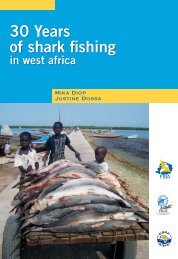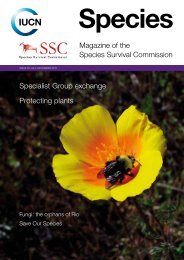Kyne & Simpfendorfer.. - Shark Specialist Group
Kyne & Simpfendorfer.. - Shark Specialist Group
Kyne & Simpfendorfer.. - Shark Specialist Group
Create successful ePaper yourself
Turn your PDF publications into a flip-book with our unique Google optimized e-Paper software.
PART 2. BATOIDS<br />
Order Rajiformes. Batoids.<br />
Family Rhinobatidae. Guitarfishes.<br />
The sole deepwater rhinobatid, the stripenose guitarfish Rhinobatos variegatus is known only<br />
from the holotype collected at 366m depth in the Gulf of Mannar off India. Guitarfishes are<br />
yolk-sac viviparous species producing litters of 1–18 pups annually (<strong>Kyne</strong> and Bennett 2002),<br />
but there is no specific information available on R. variegatus other than that given in the<br />
original description (Nair and Lal Mohan 1973).<br />
Family Narcinidae. Numbfishes.<br />
Aspects of the general biology of the numbfishes are poorly-known. The family, like other<br />
electric rays is yolk-sac viviparous, but details on the reproductive cycle, fecundity and<br />
maturity, as well as age and growth information is generally lacking. A litter size of 1–2 with<br />
a size at birth of >96mm TL has been observed in the recently described Brazilian blind<br />
torpedo Benthobatis kreffti (Rincon et al. 2001) and a litter size of two in the western<br />
numbfish Narcine lasti with size at birth probably close to 80mm TL (Carvalho and Séret<br />
2002). The Taiwanese blind numbfish B. yangi is known only from a limited number of<br />
specimens detailed in its original description while the dark blindray B. moresbyi is known<br />
only from five specimens (Carvalho et al. 2003). There remains numerous undescribed<br />
species within the family, including the deepwater Narcine sp. C [Last & Stevens, 1994] from<br />
Australia.<br />
Family Narkidae. Sleeper Rays.<br />
There is minimal information on the biology of the sleeper rays. The biology of the rare Natal<br />
sleeper ray Heteronarce garmani is ‘virtually unknown’ (Compagno et al. 1989). The two<br />
endemic New Zealand sleeper rays of the genus Typhlonarke are also rare and poorly-known,<br />
although they reportedly have up to 11 pups per litter with a size at birth of 90–100mm TL<br />
(Duffy 2003a).<br />
Family Torpedinidae. Torpedo Rays.<br />
As with other electric ray families, there is relatively little information on the biology of the<br />
torpedo rays. The biology of some shallower water species (i.e. Torpedo californica, T.<br />
marmorata and T. torpedo) is reasonably well known, but apart from some minimal data on<br />
the New Zealand torpedo ray T. fairchildi and the great torpedo T. nobiliana, there is little<br />
information on the deeper water torpedos. Most are poorly-known and one, the smalldisk<br />
torpedo T. microdiscus, is known only from two specimens collected from submarine ridges<br />
in the Southeast Pacific. A litter size of eight has been reported for T. fairchildi (see Duffy<br />
2003b), while Trunov and Kukuev (2005) noted 35 large follicles in the ovaries of T.<br />
nobiliana from the Azores and Capapé (1974) estimated a gestation period of ~12 months for<br />
that species from Tunisia. Abdel-Aziz (1994) noted that ovarian fecundity in the shallower<br />
water T. torpedo and T. marmorata is higher than uterine fecundity, and as such, actual<br />
fecundity in T. nobiliana is likely lower than the ovarian fecundity of 35 reported by Trunov<br />
and Kukuev (2005). Reported litter sizes for shallower water species are generally small, for<br />
example Abdel-Aziz (1994) reports 2–12 (average 7.2) for T. torpedo and 3–16 (9.3) for T.<br />
marmorata from Egypt, Capapé (1974) 6–10 (8) for T. marmorata from Tunisia, and Neer<br />
and Cailliet (2001) 17 for a single T. californica. Gestation is variable between shallower<br />
water species, Abdel-Aziz (1994) noting an annual reproductive cycle with a gestation period<br />
of 5–6 months in T. torpedo and a probable biennial cycle with a gestation period of 10–12<br />
months for T. marmorata. Ageing studies of the deepwater torpedos are lacking, but T.<br />
88
















